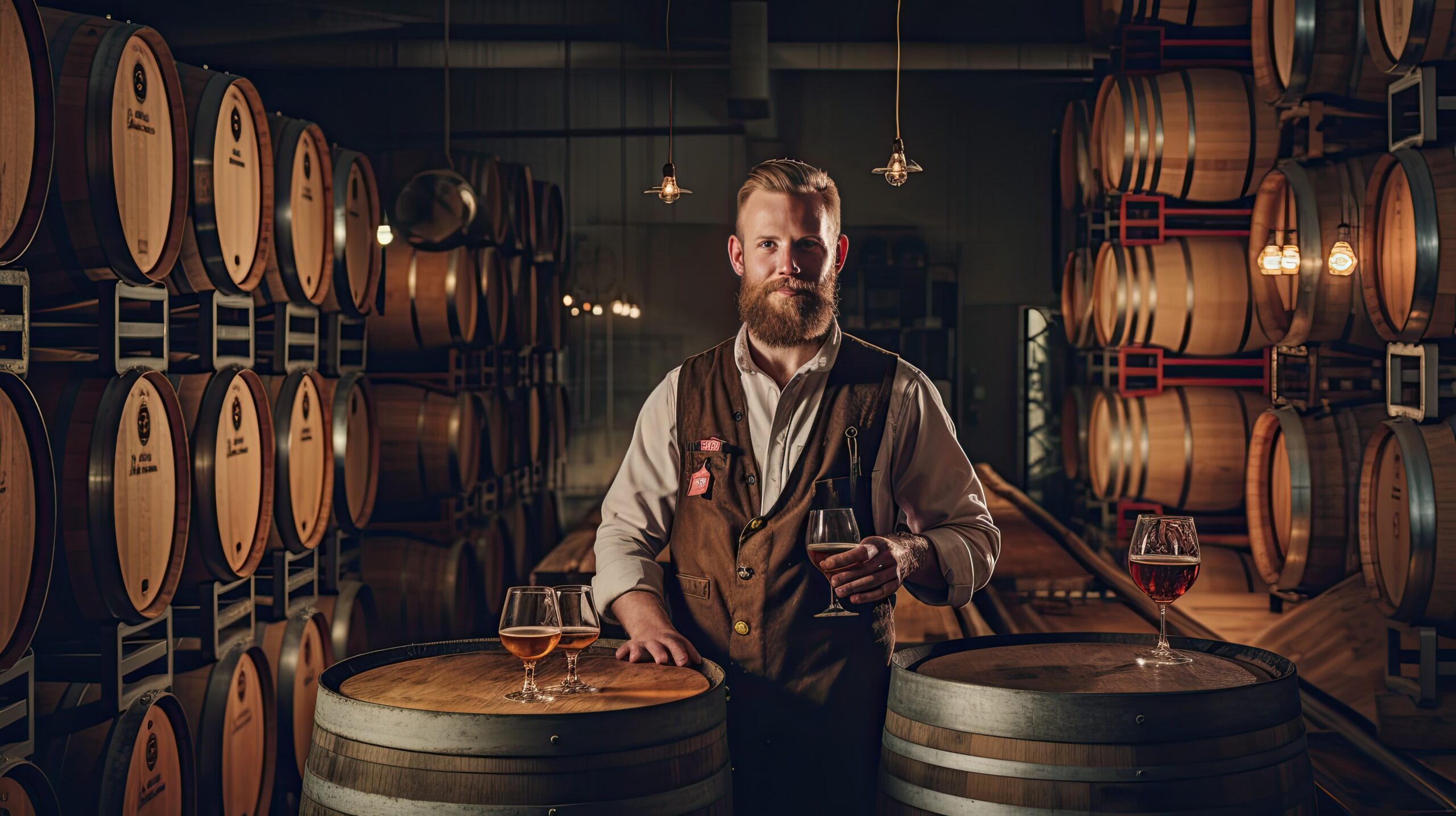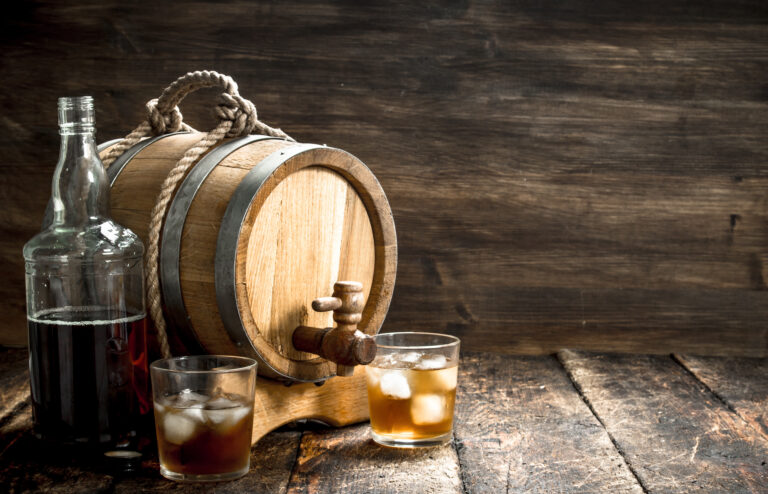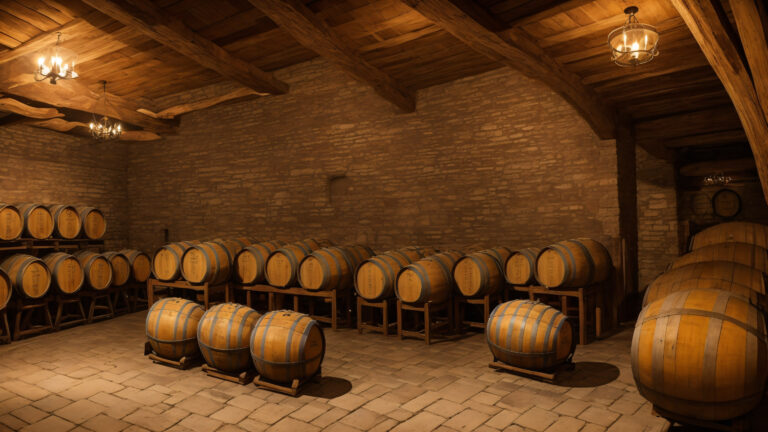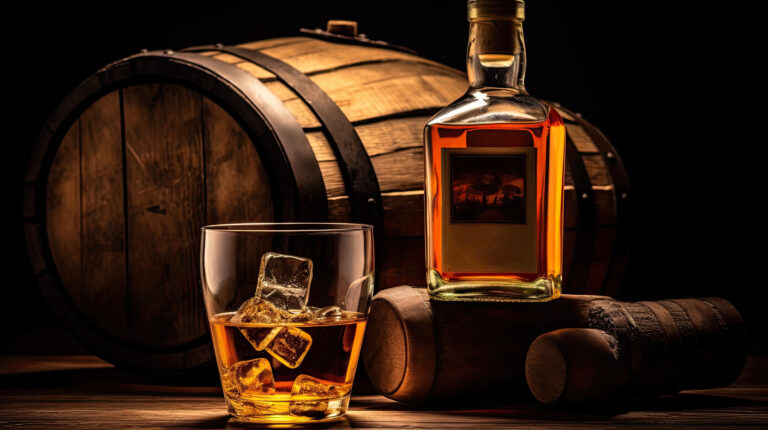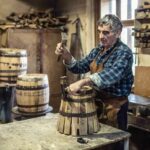You know that amazing taste of whiskey aged in charred oak barrels? It’s not magic, it’s the wood! The barrel acts like a flavor factory, infusing the whiskey with unique compounds as it matures. The type of oak, where it’s from, how it’s cut, and even how much it’s charred or toasted—it all shapes the final taste.
You might not realize just how much that wood contributes to your enjoyment of an aged whiskey. The oak variety, its growing location, how it was cut and dried, and the level of charring or toasting on the inside of the barrel are all key players in developing the complex flavors of the whiskey. The wood itself provides natural sugars, tannins, lactones, phenols, and more that mingle with the distilled spirit during maturation. Different types of oak and varying char levels create diverse flavor profiles. These wood-derived compounds are responsible for those enticing fruity, spicy, vanilla, and smoky notes that make aged whiskey so captivating.
So, the next time you savor an aged whiskey, take a moment to appreciate the unsung hero: the wood that helped craft such a flavorful spirit. That oak barrel truly shapes your whiskey into a work of liquid art.
The Silent Alchemist: How Whiskey Barrels Infuse Flavor
The kind of wood used for whiskey barrels dramatically affects the flavor of the aged spirit. Historically, oak has been the top choice, with American white oak and French oak leading the pack.
American white oak barrels lend notes of vanilla, coconut, and spice. Take Bourbon, for instance; it gets its sweet, smoky character from aging in charred new American white oak casks. The vanillin compounds naturally present in the wood are what give Bourbon its signature flavor.
French oak barrels tend to create more subtle, complex flavors with hints of clove, nutmeg, and dried fruit. Some single malt Scotches, aged in used French oak casks, develop aromatic, fruity profiles thanks to compounds in the wood’s tannins and lignins.
While less common, other woods like hickory, maple, and cherry can also be used for aging whiskey. Hickory delivers a robust, nutty flavor, maple adds a subtle sweetness, and cherry results in hints of almond and fruit. These alternative woods produce distinctly full-bodied whiskeys.
The char or toast level of the barrel also significantly impacts the taste. More heavily charred barrels lead to darker, smokier whiskeys, while lighter toasting results in cleaner, fruitier flavors. The interaction between wood and spirit is a complex dance, but the barrel’s properties are absolutely essential for crafting a high-quality aged whiskey.
Understanding how wood varieties and barrel chars influence flavor helps whiskey enthusiasts better appreciate the nuanced taste differences among their favorite spirits. The humble barrel might seem like a minor detail, but it remains one of the most vital tools a distiller has for creating complex, memorable whiskeys.
The Barrel’s DNA: Common Woods in Whiskey Aging
When it comes to whiskey, the type of barrel used during aging plays a monumental role in determining the final flavor. The most common woods you’ll find are American white oak, French oak, and used bourbon barrels.
American White Oak
American white oak barrels are incredibly popular and impart delightful notes of vanilla, coconut, and spice. This wood is porous, allowing plenty of oxygen exposure, which results in a robust, smoky flavor. Many distillers rely on white oak barrels for aging Bourbon.
French Oak
French oak barrels, often chosen for Scotch whiskies, tend to produce flavors of dried fruit like raisins or prunes. French oak is denser than American oak, leading to slower oxidation and a fruitier, sweeter flavor. Whiskeys aged in French oak might also pick up notes of cinnamon or nutmeg.
Used Bourbon Barrels
Used bourbon barrels are essentially American white oak barrels that have already held a batch of Bourbon. They still contribute vanilla and coconut flavors, but often in a more mellow way. The Bourbon absorbed into the wood means that subsequent uses pick up those delightful Bourbon flavors, resulting in a smooth, rich blend of tastes. Scotch and Irish whiskies are frequently aged in used bourbon barrels.
Ultimately, the type of wood, the level of char or toast, and any previous use all dictate how many flavor compounds get infused into the whiskey. And that, my friends, is the true art of producing an exceptional, memorable whiskey. Savor every sip!
The Wood’s Whisper: How Barrels Impart Flavor to Whiskey
The wood used to craft whiskey barrels is absolutely integral to developing the flavor of the aged spirit. As whiskey matures in the barrel, it soaks up compounds from the wood that impart notes of vanilla, caramel, and spice. The type of wood, the barrel’s char or toast level, and even the environment it’s stored in all influence how much flavor is infused into the whiskey.
American Oak
The vast majority of whiskey barrels are made from American white oak, which lends sweet vanilla and coconut flavors. Bourbon, for example, is legally required to be aged in new charred oak barrels. As Bourbon interacts with the wood over time, it develops that characteristic vanilla and caramel profile.
European Oak
Some distillers opt for barrels made of European oak, such as French oak or Hungarian oak. These woods tend to impart more spicy and savory flavors to the whiskey. For instance, whiskey aged in French oak might develop notes of clove, nutmeg, or black pepper. European oak barrels are often used to finish whiskey after its initial aging in American oak.
The Char
The level of char or toast on the inside of the barrel also affects the flavor. A lighter char or toast will produce more subtle wood flavors, while a heavier char leads to richer notes of vanilla, caramel, and smoke. Many distillers experiment with different char levels to create a unique flavor profile in their whiskeys.
The Environment
The environment where barrels are aged also plays a crucial role. Barrels aged in colder climates tend to impart more robust wood flavors to the whiskey. The expansion and contraction of the wood in response to temperature changes allow the whiskey to penetrate deeper into the wood. Warehouses with significant temperature variations often lead to more complex wood-derived flavors in the final spirit.
In essence, wood type, char level, and aging environment all work together to influence how much oak flavor is imparted to whiskey during maturation. Mastering these variables allows distillers to craft an endless variety of distinctive wood-aged spirits.
The Magic of Fire: How Charring Shapes Whiskey Flavor
When whiskey is aged in charred oak barrels, the charring process profoundly affects the flavor. As the barrel is charred, the wood breaks down and releases compounds that infuse distinctive flavors and aromas into the whiskey.
The level of char can range from a light toast to a heavy char. A lighter toast will produce more subtle flavors, while a heavy char results in more robust, smoky notes. The char creates a layer of carbon in the wood that acts as a natural filter during aging. As the whiskey interacts with the wood, this carbon layer absorbs and releases certain compounds, altering the whiskey’s flavor profile.
Compounds like vanillin, which provides that lovely vanilla aroma, and lignin, which adds spicy notes, are absorbed from the wood into the whiskey. The char also produces complex sugars that caramelize, giving aged whiskey a sweet, toffee-like flavor. Tannins from the wood contribute hints of clove and allspice.
The char also imparts distinctive smoky notes. Phenols released from the wood produce aromas reminiscent of smoked wood or tobacco. These robust, smoky flavors tend to be more pronounced in Bourbons and other whiskeys aged in heavily charred barrels.
Beyond absorbing and imparting flavor compounds, the char layer also acts as a filter. As the whiskey penetrates the wood, the char helps mellow the whiskey by absorbing harsher compounds. This leads to a smoother, mellower flavor.
The level of char combined with the length of aging helps determine how much of the wood flavor compounds make their way into the final whiskey. Master distillers meticulously control these variables to produce a whiskey with their desired flavor profile. Whether you prefer a lighter, subtler whiskey or a bold, smoky Bourbon, you have the charring process to thank for its distinctive character.
Where the Wood Whispers: Regional Differences in Barrel Wood and Taste
The type of wood used for whiskey barrels has a big impact on the flavor of the aged spirit. Barrels made from American white oak, especially those from specific regions, are highly prized for imparting distinctive taste profiles.
American White Oak
American white oak barrels are the most common for aging whiskey. This wood is porous, allowing the whiskey to absorb flavors from the wood. It also naturally contains lactones, compounds that give off a vanilla aroma. Whiskey aged in American white oak may feature notes of vanilla, caramel, and spice.
Wood from the Ozark Mountains in Missouri is sought after for its tight grain, which slowly releases flavors into the whiskey. Whiskey aged in Ozark oak might taste of maple syrup, nuts, and dried stone fruit.
Wood from Minnesota and Wisconsin has a looser grain, quickly imparting robust flavors. Whiskey aged in northern oak often strongly tastes of vanilla, coconut, and clove.
Kentucky oak wood, not surprisingly, is used to make many Bourbon barrels. Its medium grain gives Bourbon a beautiful balance of sweet and spicy notes, like candied pecans.
European Oak
European oak barrels, particularly those from Spain and France, are used for some American whiskeys. European oak has a tighter grain and higher tannin content than American white oak. Whiskey aged in European oak tends to be spicier with notes of cigar box, espresso, and dark chocolate.
The specific type of wood, its sourcing, and how it’s treated all contribute to the incredible spectrum of flavors found in aged whiskey. While distillers often keep their barrel aging regimens a closely guarded secret, exploring the world of wood finishes and regional differences can truly deepen your appreciation for the subtle taste profiles in your favorite whiskeys.
Old Friends vs. New Beginnings: Ex-Bourbon Barrels vs. New Oak Barrels
The type of wood used to make whiskey barrels significantly impacts the flavor of the aged spirit. Two of the most common woods are American white oak, used for Bourbon barrels, and European oak, typically for Scotch whisky casks. Each imparts distinctive aromas and tastes to the whiskey during maturation.
American White Oak (Ex-Bourbon Barrels)
Bourbon, by law, must be aged in newly charred American white oak barrels. This wood is porous, allowing the whiskey to absorb vanilla, coconut, and caramel flavors. As the spirit penetrates the wood, it also extracts tannins that provide notes of spice and sometimes even dill. Bourbon aged in used barrels, known as “ex-bourbon” casks, will have already imparted many of these flavors to the first batch of whiskey. However, they can still positively influence the flavor of another spirit like rum, tequila, or wine. The previous tenant may have left behind traces of richness, sweetness, and oakiness for the next spirit to absorb.
European Oak (New Oak Barrels)
European oak, especially French oak, is frequently used for Scotch whisky maturation. New European oak barrels will impart more resinous, clove-like aromas to the spirit. The wood is denser, so the whiskey penetrates more slowly, resulting in subtle flavors of citrus, berries, and chocolate. Some distillers use a mix of ex-bourbon and new French oak casks to create layers of complementary flavors in their whiskies.
Ultimately, the specific type of wood, the level of char or toast, the reuse of the cask, and the length of aging all interact to determine how much the barrel itself influences the final taste of the whiskey. Master distillers thoughtfully choose and blend barrels to create the distinctive flavors they desire in their aged spirits. The results, whether bold and spicy or fruity and smooth, beautifully demonstrate the artistry involved in crafting a superior whiskey.
The Grand Finale: Finishing Whiskey in Different Wood Types
The type of wood used for whiskey barrels significantly impacts the flavor and aroma of the aged spirit. Different woods impart distinct characteristics that become more pronounced the longer the whiskey matures.
American White Oak
The most common wood for whiskey barrels is American white oak, used to make barrels for Bourbon and other American whiskeys. White oak has tight grains that allow for slight oxidation, mellowing the spirit over time. It typically imparts notes of vanilla, caramel, and toast.
European Oak
European oak, used for Scotch whisky barrels, has wider grains that allow for more flavor infusion. Whiskeys aged in European oak take on aromas of dried fruit like raisins, apricots, and prunes. They often have a subtle smoky flavor from the wood’s higher tannin content.
French Oak
French oak barrels, often used for brandy, wine, and some single malt Scotches, produce flavors of clove, nutmeg, and black pepper. French oak has very tight grains that lead to slower maturation, allowing more complex flavors to develop over many years of aging.
Port and Sherry Barrels
Aging whiskey in used Port, Sherry, or other wine barrels results in a variety of fruity, nutty, and sometimes spicy notes. The previous contents of the barrels also seep into the whiskey, adding layers of flavor that differ based on the type of wine. These barrels are often used to “finish” a whiskey, imparting a distinct flavor profile.
The precise combination of wood type, char level, and aging time produces the incredible array of tastes, smells, and mouthfeels found in the world’s finest whiskies. Experimenting with different barrels allows distillers to create truly unique spirits that stand out from the crowd. Finding your favorite is a journey of discovery worth savoring sip by sip.
The Patient Transformation: Maturation and Evaporation in the Barrel
The maturation process in charred oak barrels is absolutely crucial for developing the flavor and aroma compounds that give whiskey its distinctive character.
Evaporation
As the whiskey rests in the barrel, some of the liquid evaporates—this is famously known as the “angel’s share.” The barrel isn’t completely airtight, allowing oxygen and moisture to interact with the whiskey. This evaporation actually concentrates the flavor and aroma compounds in the remaining liquid. The loss of volume during maturation can be 2-4% per year, though the exact evaporation rate depends on factors like humidity, temperature, and airflow in the warehouse.
The type of oak and the level of char or toast on the inside of the barrel also impact maturation and evaporation. American white oak is commonly used because its porous nature allows for more interaction between the whiskey and the wood. The barrel is charred to varying degrees, from a light toast to a deep char. A heavier char will generally lead to faster maturation and more evaporation due to the increased surface area.
As the whiskey transforms over years, or even decades, it absorbs compounds like lactones from the wood that give aged whiskeys their distinctive vanilla and coconut notes. The whiskey also breaks down lignin in the wood into aromatic aldehydes that impart fragrances of cinnamon or clove. Tannins from the oak soften over time and contribute to the whiskey’s amber color and slight bitterness.
The aging location further influences maturation. Warehouses with greater temperature variations between day and night, or summer and winter, will typically produce more complex flavors in the whiskey. The expansion and contraction of the wood in response to temperature changes helps the spirit penetrate deeper into the oak.
Whiskey that has been matured for an extended period emerges from the barrel as a concentrated, complex spirit infused with the very essence of the oak barrel. The intricate interplay between spirit, wood, and oxidation creates an incomparable aged whiskey.
FAQs: How Distilleries Master Barrel Choices for Flavor
Distilleries painstakingly choose which barrels to age their whiskey in to develop a desired flavor profile. The type of wood, char level, and previous use all profoundly impact the flavor.
Oak Wood
The most common wood for barrels is oak, usually American or European oak. Oak barrels impart flavors like vanilla, caramel, and spice. American oak tends to add more sweet, robust flavors, while European oak contributes subtle, earthy notes.
Char Level
The char level refers to how much the inside of the barrel is burned before aging the whiskey. A light char, or toast, adds subtle flavors. A medium char provides flavors like chocolate and coffee. A heavy char imparts smoky, robust flavors. Char levels are customized based on the distillery’s flavor goals.
New vs. Used Barrels
New, or virgin, oak barrels impart strong wood flavors. Used barrels, often from Bourbon or Sherry, add more nuanced flavors from their previous contents. Bourbon barrels contribute vanilla and caramel notes. Sherry casks add dried fruit and nutty flavors. Blending whiskey aged in new and used barrels creates a balanced, complex flavor.
Blending for Flavor
Master distillers meticulously blend barrels to develop a whiskey’s unique flavor profile. They consider factors like wood type, char level, barrel age, and previous use. Blending whiskey from barrels with different characteristics results in a harmonious, multi-dimensional flavor. The art of barrel selection and blending is key to creating an exceptional whiskey.
By choosing barrels made of specific wood types, customized char levels, and new or previously used barrels, distilleries can craft a signature flavor for their whiskey. The aging and blending of whiskey in these barrels transforms the raw distillate into a complex, flavorful spirit. Barrel aging is truly both an art and a science, demanding an expert palate, years of experience, and a passion for flavor.
Final Thoughts: The Unseen Architect of Your Whiskey
So there you have it. The journey from distillery to glass is an intricate process that can truly make or break the flavor of your favorite whiskey. The wood of the barrel plays such a pivotal role in developing those distinctive notes and aromas that create such amazing complexity. The next time you swirl and sniff that glass of amber-colored goodness, take a moment to consider the silent partner that helped create that experience—the oak. Its sturdy staves held and aged the spirit, gently imparting flavors of vanilla, spice, and smoke. It’s not just a vessel, but an alchemist transforming distilled spirit into liquid gold. The wood undeniably leaves its mark, an indelible imprint on taste that makes each sip truly memorable. Whiskey is poetry, and the barrel is the hand that writes the verse.
